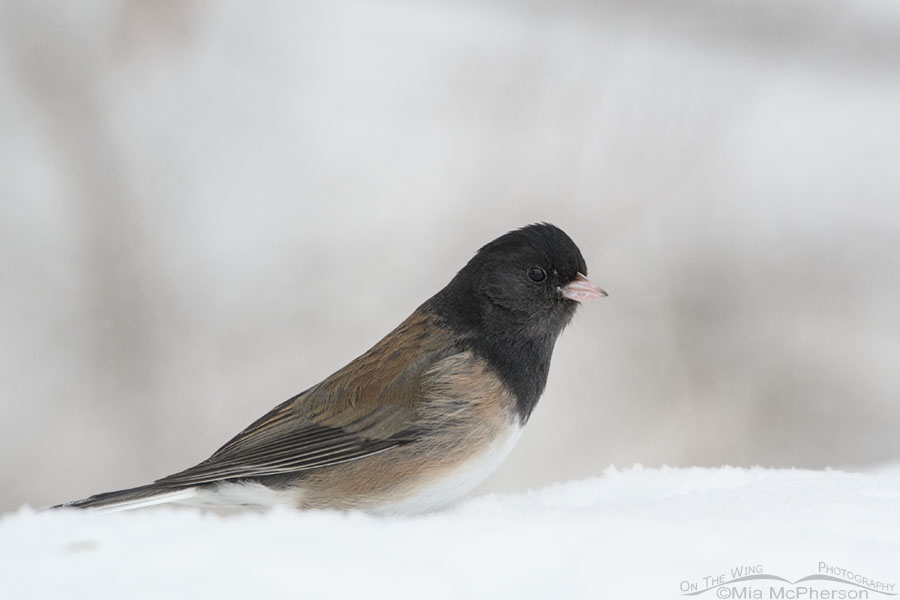 Low light Dark-eyed Junco in snow – Nikon D500, f6.3, 1/1250, ISO 1000, +1.0 EV, Nikkor 500mm VR with 1.4x TC, natural light
Low light Dark-eyed Junco in snow – Nikon D500, f6.3, 1/1250, ISO 1000, +1.0 EV, Nikkor 500mm VR with 1.4x TC, natural light
Earlier this week I photographed a male Dark-eyed Junco in snow close to home in poor, low light conditions. I am happy with how the photo turned out. Of the dozen images that I took of this individual junco looking towards me only this photo was sharp. Just barely sharp enough to meet my standards might be a better way of putting it.
This particular male Dark-eyed Junco is from the Oregon group. Back east in Virginia I had only had Slate-Colored Dark-eyed Juncos visit my yard and garden. Here in Utah I can see Oregon, Pink-Sided, Gray-Headed, and once in a blue moon, Slate-Colored too. The last time I saw a Slate-Colored Junco I was at Fishlake National Forest in central Utah and that was several years ago.
Most of the juncos I see here in northern Utah are from the Oregon group. During the fall, winter and early spring I see them in the valley at lower elevations. During their breeding season I find juncos most often at higher elevations in the Wasatch and Uinta Mountains in Utah and in the high country of Idaho and Montana.
I adore hearing Dark-eyed Juncos calls and songs because both are soft, delicate, and pleasing to my ears.
Juncos come to bird feeders in urban areas regularly and without much hesitation. Finding juncos in the forests, canyons and slopes, of the mountains can be much more of a challenge. There are times that I hear them but don’t see them and other times where I catch them diving into shrubs and bushes to take cover while I am in field. Juncos do seem to be a bit shyer to me in wilder areas than they are here in town.
Whenever I have a Dark-eyed Junco in my viewfinder I am one happy woman.
Life is good.
Mia
Click here to view more of my Dark-eyed Junco photos plus facts and information about this species.


I think some of your “low-light” shots are among your best. This is a case in point. Excellent balance of light, color and detail; overall…a beautiful pic. Thanks Mia.
I’m finding this shot very appealing. I think that the barest hint of softness is what’s making it extra special for me.
I love all the color variations. One year I tried keeping a photo log of all the differences. It quickly became over whelming.
Lovely. I am so glad that you were able to get at least one shot of this beauty which (just) met your exacting standards.
Juncos were my “first friend” here in Oregon. After a few years of trying to attract birds to my feeders, the Juncos arrived! Now, thanks to the Juncos’ advertising, there are many different bird species in my yard, but the Juncos are my most consistent friends.
PS – should have said slate colored dark-eyed juncoes
I love Juncoes. Where I live, in SW CT, we get dark-eyed juncoes. They always appear at my feeders on snow days. I’ve wondered where they go on all the other non-snow days…..they just seem to disappear. Any idea?